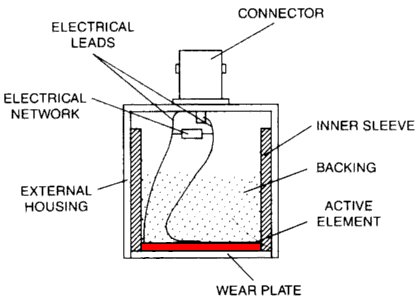Transducer Modeling
In high-technology manufacturing, part design and simulation of part inspection is done in the virtual world of the computer. Transducer modeling is necessary to make accurate predictions of how a part or component might be inspected, prior to the actual building of that part. Computer modeling is also used to design ultrasonic transducers.
As noted in the previous section, an ultrasonic transducer may be characterized by detailed measurements of its electrical and sound radiation properties. Such measurements can completely determine the response of any one individual transducer.
There is ongoing research to develop general models that relate electrical inputs (voltage, current) to mechanical outputs (force, velocity) and vice-versa. These models can be very robust in giving accurate prediction of transducer response, but suffer from a lack of accurate modeling of physical variables inherent in transducer manufacturing. These electrical-mechanical response models must take into account the physical and electrical components in the figure below.

The Thompson-Gray Measurement Model, which makes very accurate predictions of ultrasonic scattering measurements made through liquid-solid interfaces, does not attempt to model transducer electrical-mechanical response. The Thompson-Gray Measurement Model approach makes use of reference data taken with the same transducer(s) to deconvolve electro-physical characteristics specific to individual transducers. See Thompson-Gray Measurement Model.
The long term goal in ultrasonic modeling is to incorporate accurate models of the transducers themselves as well as accurate models of pulser-receivers, cables, and other components that completely describe any given inspection setup and allow the accurate prediction of inspection signals.